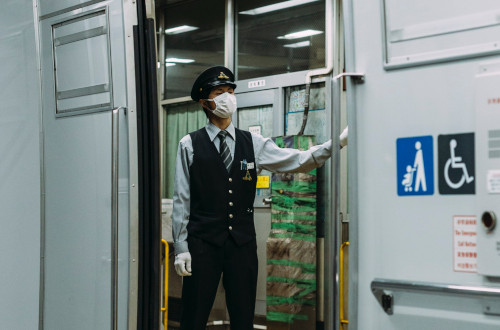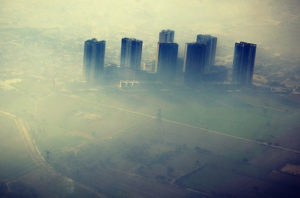Poor air quality affects us all. It affects our health and has a cost for our society, our economy and the environment. Air quality in England has improved since the 1970s, but there is still more to do.
We’re working to make sure that we meet targets to reduce emissions by 2030 and improve the air we breathe.
This page sets out:
- what air pollution is
- where it comes from
- what we can all do to reduce it
1. What air quality means
Air quality is the term we use to describe how polluted the air we breathe is. When air quality is poor, pollutants in the air may be hazardous to people, particularly those with lung or heart conditions.
Clean air is a basic requirement of a healthy environment for us all to live in, work, and bring up families. Air quality has improved significantly in recent decades, but there are some parts of our country where there are unacceptable levels of air pollution. We’re committed to reducing, as soon as possible, the most damaging pollutants in our air.
Read the Clean Air Strategy.
2. Air quality in your area
You can find out the air quality in your area on the government’s UK-Air website. It provides up to date information on air pollution and you can search by postcode. The UK-Air site also provides health advice to support people who are most at risk when air quality is poor.
Local authorities also monitor local air quality and may have information on their websites.
3. Effects on health
Air pollution is a major public health risk, ranking alongside cancer, heart disease and obesity. It shortens lives and damages quality of life for many people.
Adults and children with lung or heart problems are at greater risk of symptoms. Health advice is available for people at-risk when air quality is poor.
3.1 Top tips for reducing your exposure to air pollution
There are small changes you can make today which will reduce your exposure to air pollution. These include:
- not using your car as often for short journeys
- reducing how much you burn in your home and garden
- if you choose to burn, switching to using cleaner fuels like Ready to Burn wood and to more efficient appliances
- opening your windows when you clean, do DIY, smoke or do other activities that release pollutants directly into your home
- staying away from traffic if you’re walking or cycling (like walking on the side of the pavement furthest from the road, using the quieter roads and keeping back when waiting to cross the road)
- turning off your car engine when you park or are waiting in traffic
4. Walking and cycling
For most of us, the health benefits of walking and cycling far outweigh the risks of roadside exposure to air pollution. Aside from the health benefits of the additional exercise, it has the potential to reduce your exposure to air pollution. This is because air quality inside a car or van can be worse than it is outside.
We have committed over £300 million to improve people’s access to cycling though schemes like Bikeability and Cycle Ambition Cities. We’re also investing £100 million to improve conditions for cyclists and walkers. The Highways England Cycling Strategy shows how this money will be invested to create a cycling network.
5. Leaving the engine running (vehicle idling)
You should turn off the engine if your car isn’t moving. Idling cars can have a significant localised effect on air quality, especially around schools, care homes and train crossings.
Local authorities can issue fixed penalty notices to drivers who leave their engines running unnecessarily while their vehicles are stationary on a road.
6. Burning wood, coal or other solid fuels at home
Around 2.5 million homes use solid fuel fire or stoves.
6.1 Wood burning
Wood burning releases harmful pollutants straight into the home as well as into the air outside. Domestic burning is the UK’s largest source of particulate matter air pollution. Reducing how much you burn improves air quality for you and your neighbours.
If you use a wood burning stove, you can reduce emissions by:
- using Ecodesign ready and Defra exempt stoves
- using the right fuel (use dry wood which contains 20% or less moisture, or look for the Ready to Burn symbol)
- having the stove installed properly
- regularly maintaining the stove and chimney
- using the stove correctly
6.2 Smoke control areas
Smoke control areas are areas where it’s illegal to allow smoke emissions from chimneys. In these areas, you can only burn authorised fuels in approved appliances (exempted stoves). You can be fined up to £1,000 if you break the rules. Find out if you live in a smoke control area by contacting your local council. Learn more about rules in smoke control areas.
7. Sources of air pollution
Many substances can affect air quality. We’re committed to improving air quality in the UK by reducing emissions of the 5 most damaging pollutants. Emissions are the pollution released into the air.
7.1 Particulate matter (PM or PM2.5)
Particulate matter is everything in the air that isn’t gas. This includes natural sources like pollen, sea spray and desert dust. It also includes human made sources like smoke and dust from exhausts, brakes and tyres. PM can travel large distances with up to 33% of PM2.5 originating from non-UK sources and around 15% from natural sources. PM is classified according to size. PM2.5 is less than 2.5um (micrometers) across, and is the main type of PM which is regulated.
PM can get into the lungs and blood and be transported around the body, lodging in the heart, brain and other organs.
PM emissions have reduced significantly in recent decades, but have recently stabilised. This is partly due to an increase in wood burning in homes.
The UK already meets the 2020 concentration limit of 20ug/m3. We have made legally binding commitments to further reduce the amount of PM2.5 that we emit into our air by 2020 and 2030.
Sources of PM
Particulate emissions in the UK come from:
- 38% from burning wood and coal in domestic open fires and solid fuel stoves
- 12% from road transport
- 13% from solvent use and industrial processes
- 16% from industrial combustion (non-domestic burning)
7.2 Ammonia (NH3)
Ammonia is a gas that is released into the atmosphere, mostly from agricultural sources like slurry or other rotting farm waste and fertiliser.
It is deposited back onto land or converted into PM through reactions in the atmosphere (creating ammonium nitrate or ammonium sulphate).
Emissions from ammonia have fallen by 13% since 1990. However since 2013, there has been an increase in emissions of ammonia.
We must reduce emissions of ammonia (from the 2005 baseline) by 8% by 2020 and by 16% by 2030.
Sources of ammonia
Ammonia emissions in the UK come from:
- 88% from farming practices such as storing and spreading manures, slurries, and spreading of inorganic fertilisers
- 4% from the waste sector
- 8% from a wide range of sources such as vehicles, human waste and industry
7.3 Nitrogen oxide (NOx)
Nitrogen oxides are a group of gases that are mainly created from burning fossil fuels.
When the gas reacts with others in the air, it can create nitrogen dioxide (NO2). It also creates ozone (O3).
Nitrogen oxide emissions are decreasing and have fallen by 72% since 1970 (and 27% since 2010). We aim to reduce emissions of nitrogen oxides (from the 2005 baseline) by 55% by 2020 and 73% by 2030. The UK isn’t meeting the current limits of nitrogen dioxide concentration. We have published an air quality plan for nitrogen dioxide, setting out how we plan to meet these limits in the shortest possible time.
Sources of nitrogen oxide
Nitrogen oxide emissions in the UK come from:
- 35% from road transport
- 22% from energy generation
- 19% from industrial combustion
- 17% from other transport, such as rail and shipping
7.4 Sulphur dioxide (SO2)
Sulphur dioxide is an acidic gas which can combine with water vapour in the atmosphere to produce acid rain. Sulphur dioxide is an irritant that can affect airways, particularly in those who have asthma.
Emissions of sulphur dioxide are decreasing and have fallen by 97% since 1970.
We currently meet the legal limits for daily and hourly levels of sulphur dioxide in ambient air. We aim to reduce emissions of sulphur dioxide (from 2005 baseline) by 59% by 2020 and 88% by 2030.
Sources of sulphur dioxide
Sulphur dioxide emissions in the UK come from:
- 37% from energy generation
- 22% from industrial combustion
- 22% from domestic burning
7.5 Non-methane volatile organic compounds (NMVOCS)
Non-methane volatile organic compounds (NMVOCs) are organic molecules, which differ widely in their chemical composition but can display similar behaviour in the atmosphere. These include vapours from every day products we use at work or home like petrol, solvents, air fresheners, cleaning products and perfumes.
Emissions of these compounds are decreasing and have fallen by 66% since 1970.
We must reduce emissions of NMVOCS (from 2005 baseline) by 32% by 2020 and 39% by 2030.
Sources of NMVOCS
NMVOCS emissions in the UK come from:
- 54% from industrial emissions
- 14% from agriculture
- 8% from domestic and industrial combustion
- 5% from transport





